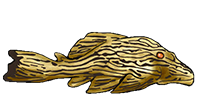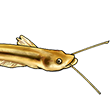Which plants can I have if any?
Which plants can I have if any?
I have a Granulosus, 2 Polli, Angelicus and 6 dwarf Petrocolas. Is there any plants that won't be eaten. Any comments are appreciated.
Thanks
Thanks
- Silurus
- Posts: 12469
- Joined: 31 Dec 2002, 11:35
- I've donated: $12.00!
- My articles: 55
- My images: 902
- My catfish: 1
- My cats species list: 90 (i:1, k:0)
- Spotted: 432
- Location 1: Singapore
- Location 2: Moderator Emeritus
- Dinyar
- Posts: 1286
- Joined: 31 Dec 2002, 00:34
- My articles: 3
- My images: 226
- My catfish: 10
- My cats species list: 3 (i:0, k:0)
- Spotted: 94
- Location 1: New York, NY, USA
- Interests: Mochokidae, Claroteidae, Bagridae, Malepteruridae, Chacidae, Heteropneustidae, Clariidae, Sisoridae, Loricariiadae
I was becoming convinced that Silurus was infallible  , so it's with a combination of disappointment and relief that I see even he slips up sometimes!
, so it's with a combination of disappointment and relief that I see even he slips up sometimes! 
Actually, your question is an entirely valid one. Most Synodontis WILL nibble on succulent plants, and some Synodontis like S. pleurops will go through zucchini, cucumber, etc. faster than any hungry pleco! None of the Synos you mention fall into the latter category, but they will eat wisteria (Hygrophila difformis) and the buds of most other plants.
You don't raise the question of which plants occur in the natural biotope of these fish (all except S. angelicus come from L. Tanganyika, as I'm sure you know). "Biotopical correctness" is not always necessary, though in this case, it does have some relevance, since I presume you are keeping your fish in water with high alkalinity and pH, and some plants are better adapted to these conditions than others. Vallisneria spp. and hornwort (Ceratophyllum demersum) are two plants that happen to be found in Lake Tanganyika. They also happen to be two plants that the Synodontis you mention will not touch.
I keep all the fish you mention with just these two plants. Note, however, that while both can be fast-growing, they need moderatey strong light to thrive. About 2 watts/gallon should be sufficient. You will also need some depth to your substrate for Vallisneria. Two inches strikes me as a good compromise. Unless you have very lush plant growth, I would not add a water column fertilizer, since algae tends to grow more easily in hard water and Synodontis are moderately messy fish.
Hope this helps.
Dinyar
Actually, your question is an entirely valid one. Most Synodontis WILL nibble on succulent plants, and some Synodontis like S. pleurops will go through zucchini, cucumber, etc. faster than any hungry pleco! None of the Synos you mention fall into the latter category, but they will eat wisteria (Hygrophila difformis) and the buds of most other plants.
You don't raise the question of which plants occur in the natural biotope of these fish (all except S. angelicus come from L. Tanganyika, as I'm sure you know). "Biotopical correctness" is not always necessary, though in this case, it does have some relevance, since I presume you are keeping your fish in water with high alkalinity and pH, and some plants are better adapted to these conditions than others. Vallisneria spp. and hornwort (Ceratophyllum demersum) are two plants that happen to be found in Lake Tanganyika. They also happen to be two plants that the Synodontis you mention will not touch.
I keep all the fish you mention with just these two plants. Note, however, that while both can be fast-growing, they need moderatey strong light to thrive. About 2 watts/gallon should be sufficient. You will also need some depth to your substrate for Vallisneria. Two inches strikes me as a good compromise. Unless you have very lush plant growth, I would not add a water column fertilizer, since algae tends to grow more easily in hard water and Synodontis are moderately messy fish.
Hope this helps.
Dinyar
- Sid Guppy
- Posts: 757
- Joined: 31 Dec 2002, 15:36
- Location 1: Brabant, the Netherlands
- Interests: Catfish, Tanganyikan fish, Rock'n'roll, Fantasy
yeah, siluris slipped away a bit....
Synodontis 'petricola dwarf' is a notorious plant nibbler! I wondered wich fish always perforated the new shoots of Vallisneria gigantea, until I cought my 6 "'S p d's'" in the act....
They also releaved me of most of the pensil- or paintbrush algae, and you should see them, when I feed peas or spinache....
I haven't got any Giant Valli's in the Tangtank anymore, but since I switched from Lamprologines to Tropheus (and thus have to feed more veggo-stuff) they absolutely thrive!
Another voracious algae- and plant nibbler is S contractus. They can clean a tank as well as any bristlenose or S pleurops. sad to know they are so rare in the trade, for this gentle, small African algae-cleaner would make a great pleco-replacement in African riverine setups. And contrary to S pleurops, they stay small; 7-8 cm or so.
A few plants suitable for Tangtanks, and syno-setups:
-Giant Vallisneria (if you feed the Syno's some greens, of course!)
-Javafern (microsorium pteropus); this plant needs to be attached to rockwork or bogwood; it's a submerged Epiphyte.
-most Cryptocorynes; easiest to keep: C affinis, C wendti de wit, C nevelli, C ponterifolia
-Javamoss (vesicularia), another wall-carpet plant (epiphyte)
-Oakleaf fern (Ceratopteris cornuta, C talictroides etc). This plant is softleafed, and they can eat it, but on the other hand; it's a fast growing plant, and burns away much nitrates. It needs much light, but it floats, so usually it's close to it anyway.
-Lemna (Duckweed) another great nutrient destroyer, like Hornworth. A 'mix' of these two I keep in most breeding tanks as hide-out for baby fish and floating cover (and watercleaner)
African plants!:
-Anubias sp; all Anubias need little light, and are hardy, thus excellent 'catfishtank-plants'! Slow growers with hard leaves. The only drawback is, they need to grow on rocks or wood to thrive. When stuck in the substrate, they rot easily; as they are 'submerged Epiphytes' and their roots need to be surrounded by water for the better part. Those roots usually are green as well.. On the other hand; if you have -like me- those PURpanels on the insides of your tank, you can stick them to it, using pieces of wooden cocktail sticks. You can carpet the back and sides of the tank in a densely leafed forest doing so. My "S p d's" use this 'Anubias forest' to spawn....Baby syno's can find refuge in it.
-Crinum natans and C calamistratum. These are plants for a BIG tank. A single Crinum can eat away as much nitrates and phosphates as a medium sized biofilter, and they're next to indestructable. They need ample light (C natans) or less (C calamistratum). These DO need to be planted well in the substrate, and sand is better than grit; they're adapted to rooting ferm in sandy riverbottoms, and their rootwork looks almost like wire..
-Nymphea lotus. Like the Crypto's, this plant has silicates in it's leaves, making it inedable for most fish. It gets, big, needs to be rooted securely, but it's a looker; very beautiful.
-Hydrilla verticillata (native Riftlake waterpest). This fast growing, messy plant does well in harder water, as it is native to Malawi and Tanganyika both. It needs much light, but aside from that, dead easy and strong too.
-Vallisneria cf spiralis; thrives in the same environment; there's a corkscrew variety native to Tang and Malawi. They do best with a little ferro-fertilizer now and then. This doesn't hurt the fish.
Last edited by Sid Guppy on 02 Feb 2003, 21:49, edited 1 time in total.
Plan B should not automatically be twice as much explosives as Plan A
- Silurus
- Posts: 12469
- Joined: 31 Dec 2002, 11:35
- I've donated: $12.00!
- My articles: 55
- My images: 902
- My catfish: 1
- My cats species list: 90 (i:1, k:0)
- Spotted: 432
- Location 1: Singapore
- Location 2: Moderator Emeritus
- Silurus
- Posts: 12469
- Joined: 31 Dec 2002, 11:35
- I've donated: $12.00!
- My articles: 55
- My images: 902
- My catfish: 1
- My cats species list: 90 (i:1, k:0)
- Spotted: 432
- Location 1: Singapore
- Location 2: Moderator Emeritus
- Jools
- Expert
- Posts: 16291
- Joined: 30 Dec 2002, 15:25
- My articles: 198
- My images: 943
- My catfish: 237
- My cats species list: 88 (i:13, k:2)
- My BLogs: 7 (i:10, p:167)
- My Wishlist: 23
- Spotted: 452
- Location 1: Middle Earth,
- Location 2: Scotland
- Interests: All things aquatic, Sci-Fi, photography and travel. Oh, and beer.
- Contact:
I second that, the picture belowDinyar wrote:Actually, your question is an entirely valid one. Most Synodontis WILL nibble on succulent plants, and some Synodontis like S. pleurops will go through zucchini, cucumber, etc. faster than any hungry pl*co! None of the Synos you mention fall into the latter category, but they will eat wisteria (Hygrophila difformis) and the buds of most other plants.
 shows fish (f3 BTW) fat on algae/auchwufs! If you add (hungry - straight from import) smaller S. pleurops into and algae ridden tank they start about it just like plecos. They are very close to the suckermouth Mochokids (sorry not sure of the sub-family) IMO.
shows fish (f3 BTW) fat on algae/auchwufs! If you add (hungry - straight from import) smaller S. pleurops into and algae ridden tank they start about it just like plecos. They are very close to the suckermouth Mochokids (sorry not sure of the sub-family) IMO.Jools
Owner, AquaticRepublic.com, PlanetCatfish.com & ZebraPleco.com. Please consider donating towards this site's running costs.





